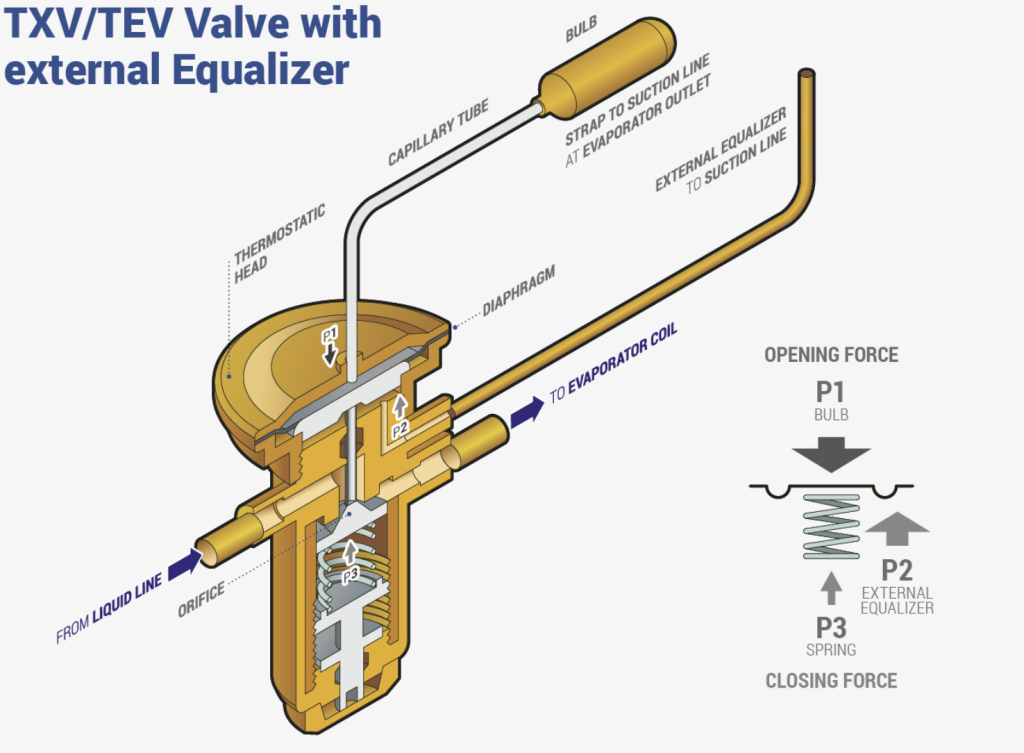Get Tech Tips
Subscribe to free tech tips.
TXV External Equalizers and Distributors

This is a quick tip from the “Expansion Valves – What Does and Doesn't Matter?” livestream on our YouTube channel featuring Joe Shearer, Matthew Taylor, and Corey Cruz. You can watch it on our website HERE.
Equalizers get their name because they provide a closing force to equalize against the bulb pressure (an opening force). Their goal is NOT to even out pressures during the off cycle but to give the TXV a pressure reference point that also counteracts its opening force.
The closing force supplied by the equalizer accounts for pressure drops. A pressure drop indicates the resistance to refrigerant flow through the evaporator. When we have small coils, that pressure drop across the evaporator is quite small; we can get that equalizing force from the outlet side of the TXV. That’s internal equalization. However, we’ll often come across evaporator coils with more hardware, including distributor tubes and external equalizers.
External equalizers and distributor tubes often go hand in hand, so we’ll take a look at what they do and how they work together.
Distributors
Distributors at the end of the TXV have small tubes that feed refrigerant into different rows of the evaporator coil. They are part of the metering device in the sense that they accomplish the pressure drop. (Remember: the metering device is the “pressure dropper.”) The image below shows distributor tubes in blue.

However, we can also think about pressure drops in terms of the evaporator coil and the need to give the TXV a reference for the equalizing force. While a TXV that feeds the evaporator coil via a single piece of tubing won’t set the refrigerant up to have too much of a pressure drop across the evaporator, With that frame of mind, we can think of the distributor tubes as little evaporators in the sense that they have a pressure drop associated with them.
A TXV with an internal equalizer won’t account for the much bigger pressure drop created by the distributors. In other words, our reference for our TXV bulb won’t be accurate.
External Equalizers
External equalizers connect to the suction line. They give the TXV a reference for the evaporator pressure, and that pressure translates to a closing force on the TXV.
Larger coils have a much larger pressure drop than smaller coils, so the pressure at the sensing bulb will be way different than at the evaporator inlet. An internally equalizing valve, which reads suction pressure atthe evaporator inlet, just won’t cut it; we need a reference closer to the bulb.
Where should the bulb be in relation to the equalizer?
The textbook answer here is that the equalizer line should be downstream of the bulb on the suction line. That’s the configuration shown below.

However, in practice, you can technically put the equalizer on either side of the bulb and see slightly different effects. Putting the equalizer downstream of the bulb will optimize your superheat; the load will be prioritized.
Putting the equalizer upstream of the bulb will focus on protecting the compressor. In the rare event a TXV leaks liquid refrigerant through the equalizer line, the bulb will sense this flooding and close the TXV to maintain its original superheat.
It’s really more about the result you want to get from the bulb placement than equalizer positioning.
Blocked Equalizers
An external equalizer can become blocked by something like a piece of solder. They are also often connected to a Schrader port, and a Schrader core that isn’t depressed may cause similar problems.
The ultimate result of a blocked external equalizer is that the TXV will remain closed and never open again, but there are a few things that will happen leading up to it.
Initially, a blocked external equalizer could cause the TXV to read zero evaporator pressure. Since the external equalizer provides a closing force, that lack of pressure would allow the TXV to open wider than it should. A TXV that is open too wide will lead to flooding.
However, valves often leak a bit, and the pressure will climb from the valve side during the off cycle or nitrogen pressurization, eventually causing the external equalizer line to fill with refrigerant. The valve responds to the increased change in pressure and gradually closes shut. With no way for the pressure to bleed back out, the valve becomes permanently slammed shut.
The TXV has two main goals: drop the pressure of refrigerant entering the evaporator coil and maintain a set superheat. Distributor tubes help out with the pressure drop, and the external equalizer helps provide an accurate reference to help the valve maintain the correct superheat.
P.S. – You can learn a lot more about how TXVs work, especially when it comes to the pressures that act on them, from THIS free webinar by Danfoss (available on the HVACR Learning Network).











Comments
To leave a comment, you need to log in.
Log In